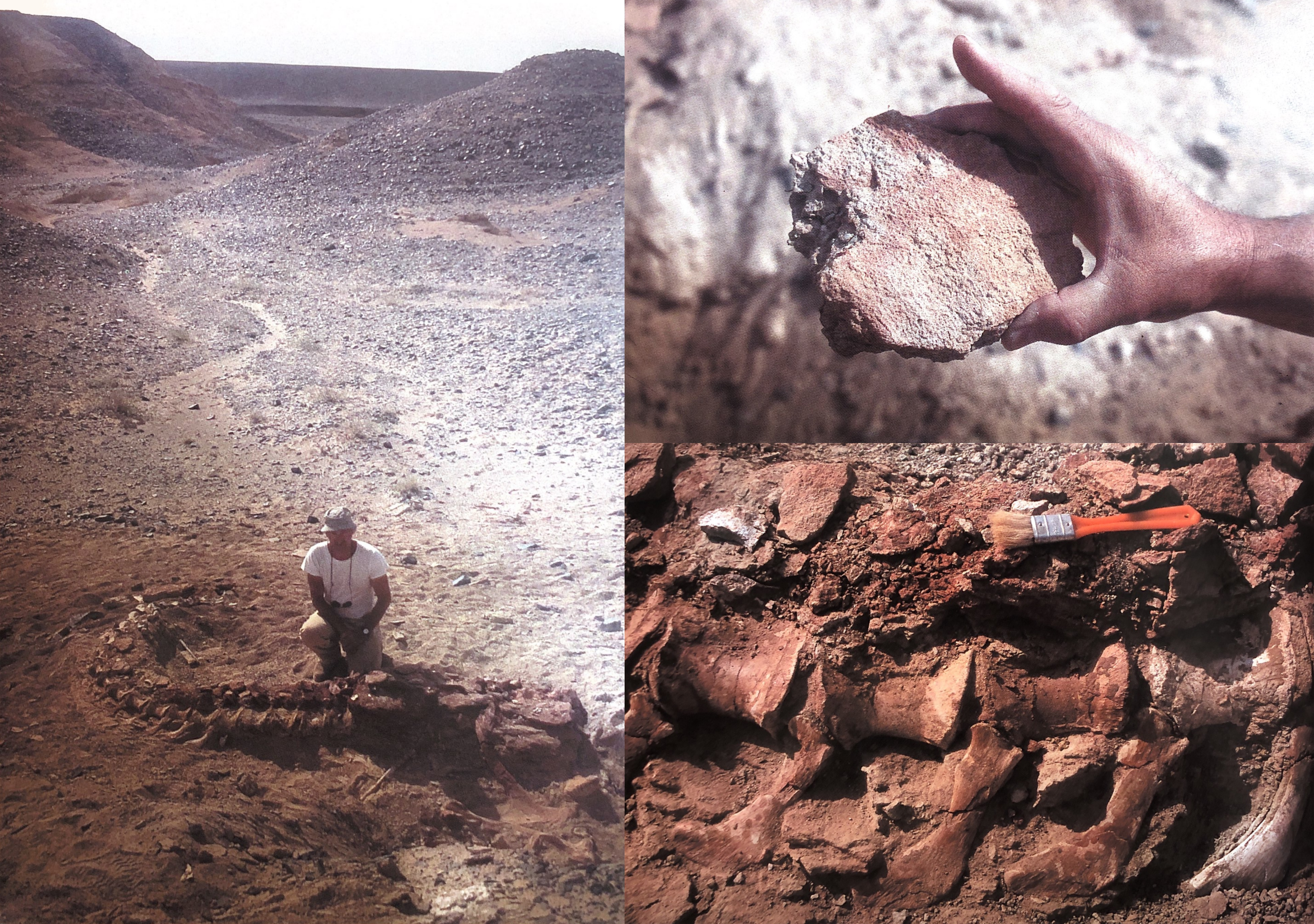
The lost Tarbosaurus mummy: the whole specimen (left), a patch of skin impressions (top right), and tail vertebrae with skin impressions (bottom right). Photos from MNHN (1992).
Previously I discussed the lost “throat pouch” of Tarbosaurus and Saurolophus skin misidentified as Tarbosaurus. This time comes a find that dwarfs them all – a lost Tarbosaurus mummy! A partial skeleton was discovered at the Nemegt locality, Mongolia by the Italian-French-Mongolian expedition in 1991. It consisted of an articulated, mostly-complete pelvis, tail, and hindlimbs with extensive skin impressions on the dorsal side. Photographs of this specimen were first published in the book Dinosaures et mammifères du désert de Gobi (MNHN, 1992). They were taken by French paleontologist and expedition member Philippe Taquet. Besides the photos, the book only contained brief mentions of the mummy.
“Au pied de le pente, dans un canyon désolé et sauvage, se trouvent les restes squelettes de Tarbosaures. L’un d’eux comprend en parfaite articulation toutes les vertèbres de la queue, les os du bassin et des pattes postérieures, et l’empreinte de la peau de ce Reptile impressionnant se distingue parfaitement sur le sédiment encaissant.”
“At the foot of the slope, in a desolate and savage canyon, lie the skeletal remains of tarbosaurs. One of them includes in perfect articulation all the vertebrae of the tail, the bones of the pelvis and the hind legs, and the imprint of the skin of this impressive reptile stands out perfectly on the surrounding sediment.”
“[…] lors de la mission italo-franco-mongole de juillet 1991, R. Barsbold et ses collègues nous ont montré dans la vallée de Nemegt de grands fragments gardant l’empreinte magnifiquement conservée de la peau d’un Tarbosaurus; […]”
“[…] during the Italo-Franco-Mongolian mission of July 1991, R. Barsbold and his colleagues showed us in the Nemegt Valley large fragments bearing the magnificently preserved imprint of the skin of a Tarbosaurus; […]”
Taquet later described it in more detail in his book Dinosaur impressions (Taquet, 1994/1998).
“We finally reached the famous Nemegt Valley, where the Russian and then the Polish-Mongolian expeditions had collected so many fossils. […] At the foot of our camp, a deep canyon stretched away; at the bottom of this canyon, the next day, our Mongolian colleagues brought us to examine the back half of a superb skeleton of one of the giant carnivorous dinosaurs. All the tail vertebrae, all the hip bones, and a good part of the hindlimbs were embedded in the sandstones in perfect articulation. […] Rinchen Barsbold showed us something unusual that he had discovered about this specimen, however: The impression of the reptile’s skin on the sandstone had been preserved, thanks to the exceptional conditions of fossilization. Here, when the animal died, it was buried such that its skin still clung to its bones, no doubt stretched and dried out like the camel carcasses that you can see in the desert today. The dry climatic conditions, added to the fine-grained sediment that faithfully preserved every detail, provided us with a pretty good idea about this dinosaur’s skin. […] It seemed to be made of small scales, whereas the ornithopod dinosaurs’ skin comprised large scales, with islands made of larger platelike scales.“
Unfortunately, this specimen was not collected by the expedition. This is especially devastating because these would have been the largest skin impressions known from Tarbosaurus and probably any other tyrannosaurid. They appear to be formed of small, pebbly scales like other tyrannosaur impressions, and indicate that this integument type covered most of the hips and tail. The mummy may have been poached; the Japanese-Mongolian expedition of 1993 reported that a similar-sounding skeleton had been destroyed in this manner (Watabe & Suzuki, 2000). Even if it was not, it was almost certainly destroyed by erosion eventually.
“It became clear that in the Western Sayr (named by the Polish expedition team) [sub-locality of the Nemegt locality], the articulated postcranial skeleton of Tarbosaurus with skin impression that had been discovered and left in field in 1992 [ wrong year? 1991?] had been destroyed by someone.”
Special thanks go to Nathan Cochran, who first informed me about this specimen.
References
- Muséum national d’histoire Naturelle [MNHN]. (1992). Dinosaures et mammifères du désert de Gobi.
- Taquet, P. (1998). Dinosaur impressions: Postcards from a paleontologist (K. Padian, Trans.). Cambridge University Press. (Original work published 1994)
- Watabe, M., & Suzuki, S. (2000). Report on the Japan-Mongolia Joint Paleontological Expedition to the Gobi desert, 1993. Hayashibara Museum of Natural Sciences Research Bulletin, 1, 17–29.
